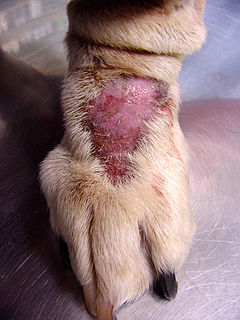
Granuloma inguinale is a bacterial disease caused by Klebsiella granulomatis characterized by genital ulcers. It is endemic in many less-developed regions. It is also known as donovanosis, granuloma genitoinguinale, granuloma inguinale tropicum, granuloma venereum, granuloma venereum genitoinguinale, lupoid form of groin ulceration, serpiginous ulceration of the groin, ulcerating granuloma of the pudendum, and ulcerating sclerosing granuloma.

Pyogenic granuloma is a vascular lesion that occurs on both mucosa and skin, and appears as an overgrowth of tissue due to irritation, physical trauma, or hormonal factors. It is often found to involve the gums, the skin and nasal septum, and has also been found far from the head such as in the thigh.

A lick granuloma, also known as acral lick dermatitis, is a skin disorder found most commonly in dogs, but also in cats. In dogs, it results typically from the dog's urge to lick the lower portion of one of their legs.

Granuloma annulare is a fairly rare, chronic skin condition which presents as reddish bumps on the skin arranged in a circle or ring. It can initially occur at any age and is four times more common in females.

Eosinophilic granuloma is a form of Langerhans cell histiocytosis. It is a condition of both human and veterinary pathology.

Silicone granulomas are a skin condition that occur as a reaction to liquid silicones, and are characterized by the formation of nodules.
Mercury granulomas is the result of mercury exposure, a skin condition characterized by foreign-body giant cell reaction.
Beryllium granulomas is a skin condition caused by granulomatous inflammation of the skin which may follow accident laceration, usually in the occupational setting.

Zirconium granulomas are a skin condition characterized by a papular eruption involving the axillae, and are sometimes considered an allergic reaction to deodorant containing zirconium lactate. They are the result of a delayed granulomatous hypersensitivity reaction, and can also occur from exposure to aluminum zirconium complexes. Commonly, zirconium containing products are used to relieve toxicodendron irritation. The lesions are similar to those from sarcoidosis, and commonly manifest four to six weeks after contact. They appear as erythematous, firm, raised, shiny papules. Corticosteroids are used to ease the inflammation, but curative treatment is currently unavailable.
Majocchi's granuloma, which is a localized form of fungal folliculitis, is a skin condition characterized by a deep, pustular plaques and is a form of tinea corporis. Lesions often have a pink and scaly central component with pustules or folliculocentric papules at the periphery. The name Majocchi's comes from the Professor Domenico Majocchi who first discovered the disorder in 1883. Domenico Majocchi was a professor of dermatology at the University of Parma and later the University of Bologna. The most common dermatophyte is called Trichophyton rubrum. This disease commonly affects both immunocompetent and immunocompromised hosts. However, immunocompromised individuals have a higher risk.
Localized granuloma annulare is a skin condition of unknown cause, tending to affect children and young to middle-aged adults, usually appearing on the lateral or dorsal surfaces of the fingers or hands, elbows, dorsal feet, and ankles.

Generalized granuloma annulare is a skin condition of unknown cause, tending to affect women in the fifth and sixth decades, presenting as a diffuse but symmetrical, papular or annular eruption of more than ten skin lesions, and often hundreds.
Patch-type granuloma annulare is a skin condition of unknown cause, more commonly affecting women between 30 and 70 years of age, characterized by flat or slightly palpable erythematous or red-brown skin lesions.
Subcutaneous granuloma annulare is a skin condition of unknown cause, most commonly affecting children, with girls affected twice as commonly as boys, characterized by skin lesions most often on the lower legs.
Perforating granuloma annulare is a skin condition of unknown cause, usually appearing on the dorsal hands, presenting as papules with a central keratotic core.
Granuloma annulare in HIV disease is a skin condition characterized typically by papular and generalized skin lesions.
Annular elastolytic giant-cell granuloma is a cutaneous condition characterized histologically by a dermal infiltrate of macrophages.
Actinic granuloma is a cutaneous condition characterized histologically by a dermal infiltrate of macrophages.
Granuloma multiforme is a cutaneous condition most commonly seen in central Africa, and rarely elsewhere, characterized by skin lesions that are on the upper trunk and arms in sun-exposed areas. It may be confused with tuberculoid leprosy, with which it has clinical similarities. The condition was first noted by Gosset in the 1940s, but it was not until 1964 that Leiker coined the term to describe "a disease resembling leprosy" in his study in Nigeria.





